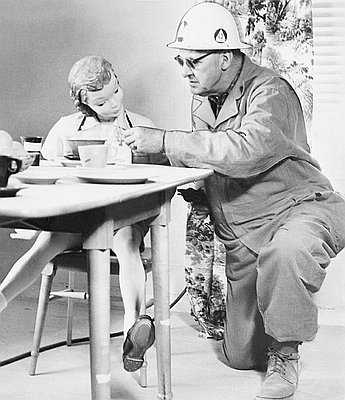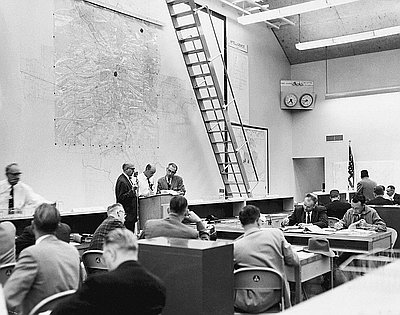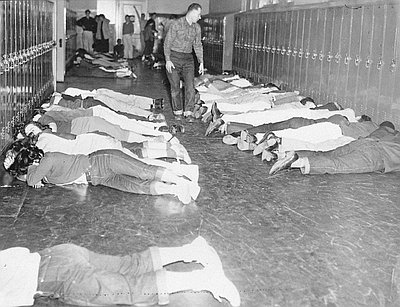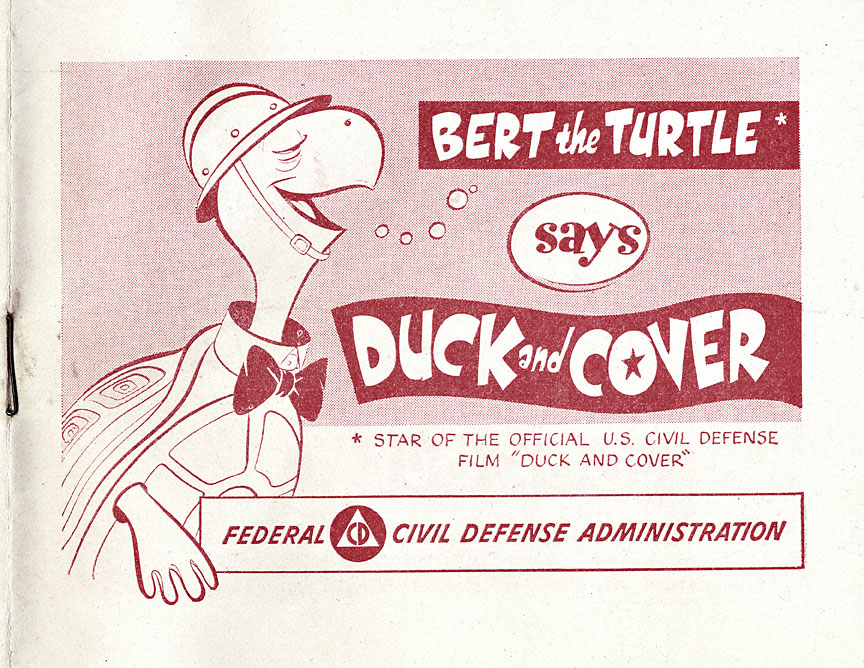- Catalog No. —
- Mss 1783
- Date —
- c. 1951
- Era —
- 1950-1980 (New Economy, Civil Rights, and Environmentalism)
- Themes —
- Government, Law, and Politics
- Credits —
- Oregon Historical Society
- Regions —
- None
- Author —
- Lars Calonius, Archer Productions, Inc.
Duck and Cover, Civil Defense Pamphlet
The pamphlet Duck and Cover was produced for the Federal Civil Defense Administration (FCDA) in 1951. In addition to the 20 million copies of this pamphlet distributed by the FCDA, Duck and Cover was also released as an animated film, a record album, and a radio program. This civil defense program was designed specifically to help educate and organize the nation’s youth in the event of a nuclear attack by the Soviet Union.
In 1949, the Soviet Union successfully detonated an atomic weapon, ushering in an era of nuclear brinksmanship with the United States that lasted for much of the remainder of the twentieth century. Subsequently, early atomic-age civil defense efforts were undertaken in the U. S. with the assumption that the nation’s largest cities would be among the nation’s primary targets. Federal efforts to educate the public about the risks of an atomic attack and strategies to survive took many forms, including the promotion and distribution of short films, radio programs, news articles, posters, and pamphlets. By promoting readiness in the face of atomic war, administrators of the FCDA hoped to alert the public to the dangers of atomic war, alarming them enough to participate in civil defense programs but not enough to panic or become fatalistic.
Duck and Cover was officially released as a film in 1952 by Archer Productions, Inc., a New York advertising firm contracted to produce it for the FCDA. The film’s first public viewing came in January, as part of an FCDA-sponsored traveling show called “Alert America,” which toured the country for nine months in 1952. Beginning in March, with the endorsement of the National Education Association, the film was shown in schools across the United States. The animated main character, Bert the Turtle, provided students with a cheery instructor to guide them in the most up-to-date survival strategy for a nuclear attack. The plan was simple and straightforward. At the first warning of attack, “Like Bert, you duck to avoid the things flying through the air…and cover to keep from getting cut or even badly burned.”
According to the FCDA, “If DUCK AND COVER is carefully integrated with a study of civil defense, it can help your pupils acquire a quick and easy technique for self-protection from an atomic explosion as well as help them understand the need for civil defense.” Unfortunately, the advent of hydrogen-bomb technology in 1952 made Bert the Turtle’s advice worthless, allowing for the development of weapons hundreds of times more powerful than those dropped on Hiroshima and Nagasaki, Japan during World War II. Nuclear weapons developed throughout the remainder of the twentieth century were even more powerful convincing many Americans that the only way to survive a nuclear attack would be to prevent one from happening in the first place.
Further Reading:
Grossman, Andrew D. Neither Dead nor Red: Civilian Defense and American Political Development during the Early Cold War. New York, 2001.
McEnaney, Laura. Civil Defense Begins at Home: Militarization Meets Everyday Life in the Fifties. Princeton, N.J., 2000.
Written by Joshua Binus, © Oregon Historical Society, 2004
Related Historical Records
-
Bill Browne & Dummy A-Bomb Test, 1955
This photograph originally appeared in the Oregon Journal, one week prior to the Federal Civil Defense Administration’s (FDCA) “Operation Cue,” a televised demonstration to test the effects of …

-
Civil Defense Underground Headquarters
In 1956, Portland became the first city in the United States to build an underground city hall, the Civil Defense Emergency Operation Center, at Kelly Butte, six and …

-
Lincoln High School Air-Raid Drill, 1950
This photograph originally appeared in the Oregon Journal as an illustration for an article by Dan Flanagan, titled “Portland Schools Map Air Raid Precautions.” The air raid drills …

